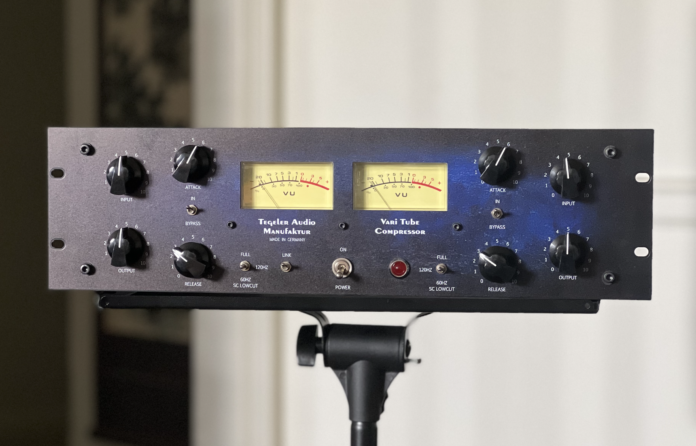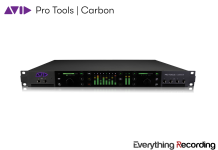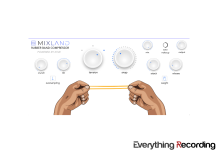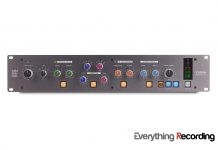Hailing from the land of Bosch, BMW, and the Bavarian Pretzel, Tegeler Audio Manufaktur are steadily winning hearts, minds, and rack space. B. Church patches in Tegeler’s OG: The VTC.
COMPRESSORS, COMPRESSORS EVERYWHERE
It’s weird, we hadn’t reviewed a hardware compressor in a while and then, seemingly out of nowhere, a month doesn’t go by where I’m not wiring up a new box of chips, bulbs, and wires to fawn over. You’d think I’d be getting bored of this. Heck, I was starting to wonder if I’d start feeling the crisp by now, too. But talking with Tegeler Audio Manufaktur of Berlin about an upcoming product, I kept mentioning, “hey, but we uh, sure would love to give that tube compressor a try.”
Though the Tegeler VTC (Variable Tube Compressor) has been around for a bit, the Tegeler name has been popping up more and more lately in the US – like a guarded industry secret. It feels like the ‘in the box’ revolution has been coming full circle, with even the most binary-minded diehards adding summing amplifiers and a few choice bits of analog space heaters. At the same time, engineers who’ve come of age long after the DAW revolution took hold are venturing out of their computers’ friendly confines once they get a taste of what a solidly-built piece of outboard adds to their mixes.
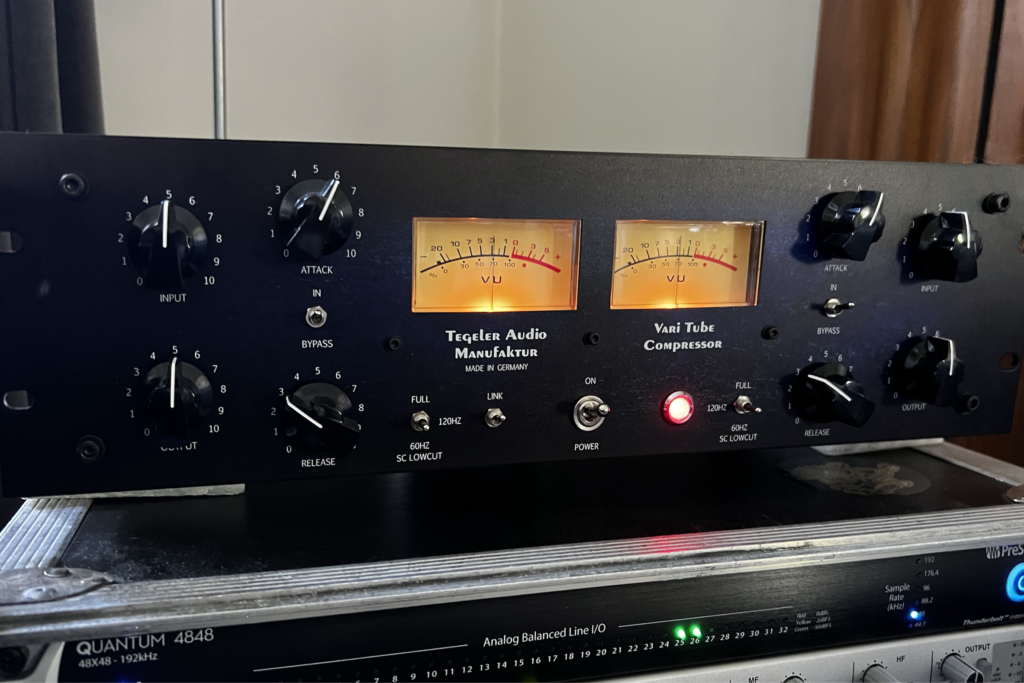
WHAT IT IS, WHAT IT IS NOT
The VTC most definitely IS an all-tube Delta Mu compressor from boutique manufacturer Tegeler. With a US street price of just under $2200 (available excl. through Vintage King), this puts the classic tube compression sound in mix and mastering studios at an extremely modest price. Seriously, go check the competitors, I’ll wait here.
Boasting two pairs of tubes (2 x E88CC, 2 x 12AX7) and transformers from Vigortronix, the VTC is a 3RU variable tube compressor that chooses to keep things simple. Not to paint with too broad a brush, but the Delta Mu* design leans on you to trust your ears and not numbers. You reach for this kind of compressor for its harmonic-rich saturation, gossamer top end, and amplitude-dependent response. If you’re looking for transparency, you’ve come to the wrong place. But hey, since you’re here…

(* “Delta Mu” is not a fraternity. It’s electrical engineer parlance, and they love their Greek lettering. “Delta” merely signifies something being a variable quantity, “Mu” refers to gain. So yeah, fancy as it sounds, it just means “variable gain”. Also the good folks at Manley have taken out a trademark on the term “Vari-Mu”, so we’ve edited accordingly.)
A STUDIO GOLIATH, NOW IN “DAVID-SIZE”
Ask any seasoned engineer to name a compressor that is an absolute legend and I’m willing to bet more than a few namecheck the grand poobah itself: The Fairchild 670. If you’ve never worked on one, all I can really say is that the godlike, bigger-than-huge sound it’s synonymous with? That’s not hyperbole. I’ve been lucky enough to session on several in my so-called ‘career’ and they are as big sounding as they are… well… big.
And since many of us are unable or unwilling to pony up tens of thouands of dollars for a sixty-five pound, six-rack-space behemoth (and aren’t satisfied with another artificially patinated graphical interface) a few manufacturers have been evolving the design. Manley’s Vari-Mu, for example, can be found in many, many well-appointed mix and mastering rooms. DW Fearn’s VT-7 is another example of a forward-footed tube compressor that is capable of adding tremendous presence and weight.
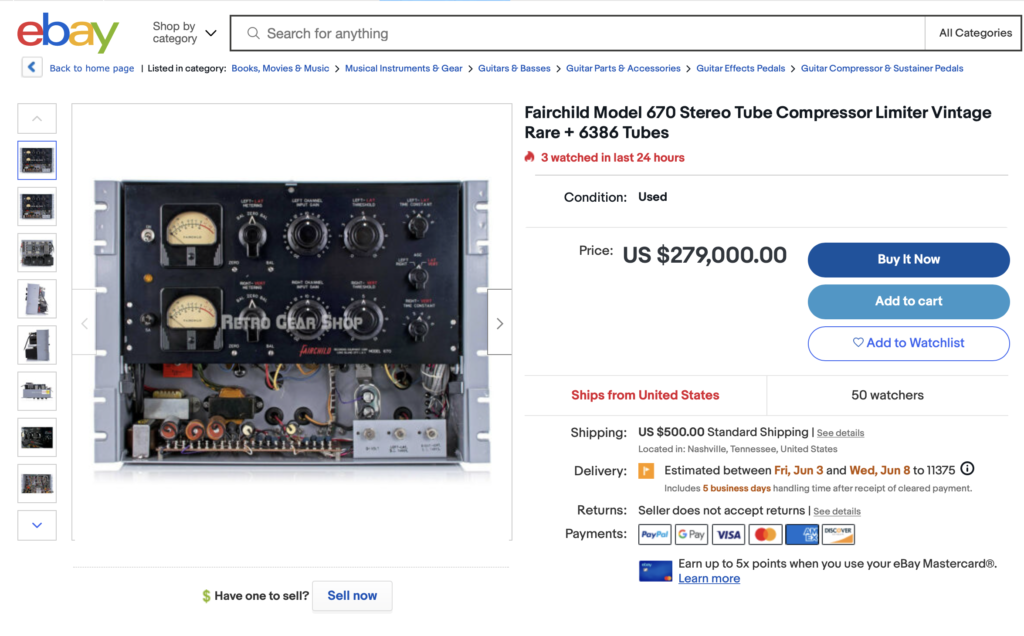
Look, if you want the Fairchild? They’re out there.Standing upon the shoulders of these Goliath devices, Tegeler’s VTC was among their first forays into the market. Lighter on your lower back and your bank account, this screams “instant classic” (and, ‘hurry up with those patch cables’). Pulling its beefy 3RU chassis from Tegeler’s trademark wooden ‘treasure chest’, I could already tell looking upon its ocean-blue-flashed fascia that this was an heirloom piece of gear. A Fairchild in the making.
The front panel controls are laid out logically and feature nothing that should require a manual (though one is provided in actual printed form). The left and right sides are almost identical, sporting input and output trim levels, attack and release times, a stereo link toggle, and a three way switch to engage a sidechain HPF at 80 or 160hz (right below E2 and E3 on a piano, respectively). Absent a threshold control, you simply drive the inputs until your ears reach Valve-halla.
The controls are my absolute favorite – straddling the fence between continuous and stepped with many finite, but easily-recallable clicks. Seeing as how the VTC has equal appeal to mixing and mastering applications, this is the perfect middle-ground. The centered VU’s burn warmly in a “cat eye” orange, providing tactile, ample display of the amount of squeezing that’s taking place.
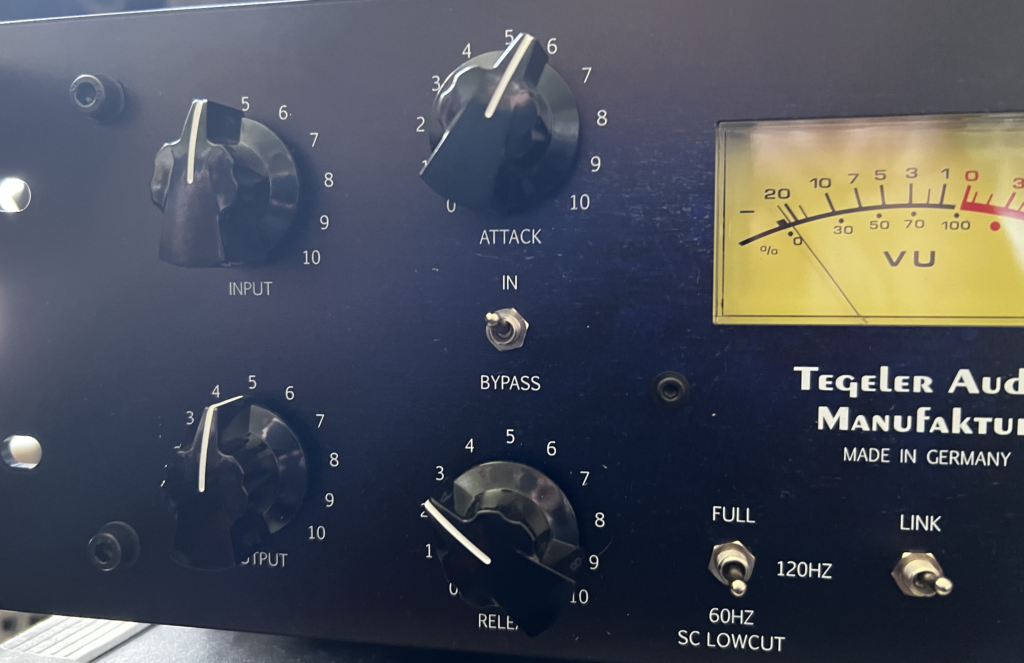
If you’re anticipating surgical control over your dynamics, this may not be the ideal fit for you (then again, it might be!). When using the triode tubes as the actual gain cell, there’s no such animal as a threshold or even a ratio. Like the many, many fine automobiles Germany produces, there’s a “power band” to its engine; a certain range of input level where you’re getting the absolute best of what it’s built for. It comes on subtly when the needles begin to dip, but push deeper and the ratio and knee tighten up. This is where the Tegeler’s wisely-included sidechain HPF switch often saves the day, keeping kicks and low basses from blowing the whole thing up.
You sense the past inspiring the future – from the ginormity of its metering to the large bakelite controls. Powering the unit on with the undeniable ‘thwack!’ of a toggle switch and indicator bulb plucked from the industrial 1950’s, my heart and the VTC’s innards began to glow as it yawned, stretched, and laced up to put in work.
I WAITED AT LEAST MOST OF THE RECOMMENDED THIRTY MINUTES
If tube gear is new to you, you should know that these Edisonian bulbs can be a little cranky in the morning. Let them get a cup of coffee for optimal results (the same is true for new units, they need ‘burn-in’ time). In all fairness, I tried. I think I made it twenty minutes, eight seconds.
For several days I’ve been agonizing over the same mix. It’s a personal project I’m doing with a friend who, as irony would have it, was one of the artists I first recorded in my crummy Ithaca, NY house as a college student decades ago. Strapped across my stereo bus, I switched the circuit in. Now, as often happens, your compressed return signal is louder – and louder often signifies ‘better’ on first blush, even to those of us who’ve been fooled a million times before.
But what I heard was not louder. It was 2db quieter and 3 times bigger. All of the sudden, the details that had plagued me for revision after revision had woven themselves into a tapestry. The VTC’s tubes and transformers took to the high-end’s cymbals and overtones like a polishing wheel, adding an impossible combination of hazy and bell-clear. The Tegeler doesn’t ‘sizzle’ or ‘sear’ the top like tube devices can – it creates the audio equivalent of a perfect golden sunset.
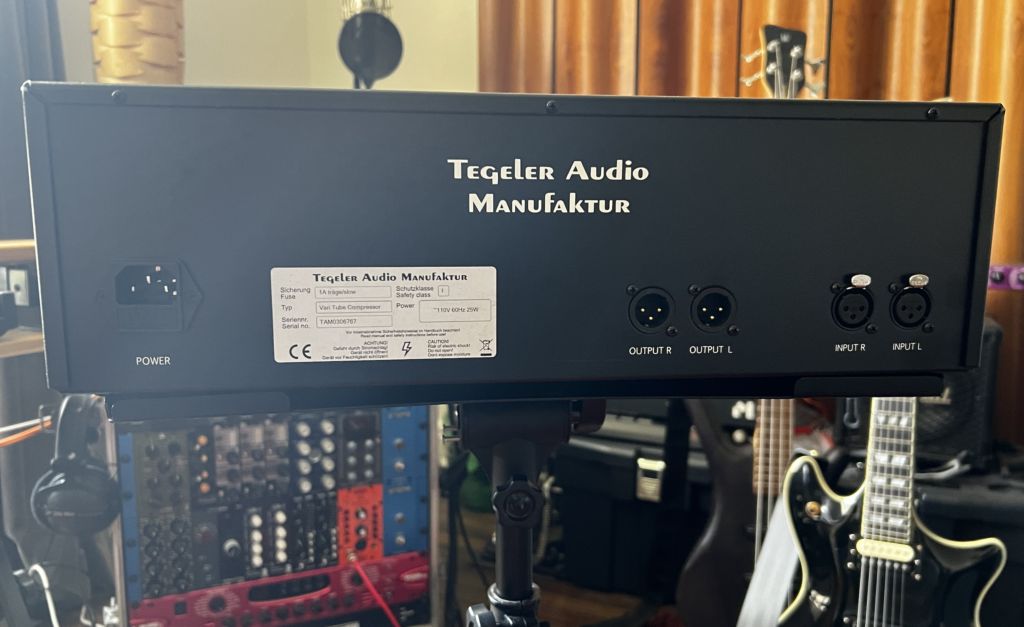
In the space between the kick and snare, the VTC puffed out the mix’s chest – almost-but-not-quite to the point of audibly pumping. It effortlessly gelled together the song’s kick, bass drum, and low-B guitar chords – conjoining them into a cohesive sway, much like the breathing of cello bows. The ethereal, wispy (and wet) multi-layered vocals were enveloped into a warm embrace – finding their space inside an absolute mountain of crashing room mics, a meaty Ampeg SVT cabinet, and stacks of guitars.
What had been two weeks of not-quite-right was finished within thirty minutes. I printed off a mix with “_done?” as a file identifier and heard back from my partner in the amount of time it took to download, play the song and respond: “Wow. Who mixed this?” Passive-aggressive joking aside, I did a quick A/B against the last version (using a combination of an IGS S-Type 500 and Oxford Inflator). Now, the old version was good. Maybe even, “pretty good.” But the Tegeler spun our silvery-lead into 24 karat gold.
MAKING A BOOM… BOOM.
Before I could even reset anything, I knew I had to hear this beast on drums. Whether you’re talking a breakbeat or an entire sixteen-or-more channel multi-mic setup, the VTC is dying to be unleashed on any stereo bus or source. I mean, I guess you could split it up into dual mono duties for tightening individual drums or mics, but for drums I really liked turning up on the big picture, not the tiny details.
Starting with a test session I keep around with just four mics (kick in, snare top, and overheads being pushed pretty hard through a classic Trident 80B console), it took all of maybe twenty seconds to find the magic spot. With the sidechain’s HPF switched out and the meters indicating a good amount of action, the kit had swagger and bombast, charging like an angry bull with tremendous weight.
Now remember, this is a minimal design here – no threshold, no ratio, no adjustable knee, or external sidechaining. So I took the kick drum out of the bus and backed the input down to just maybe 2-3db on the hardest of the hits. The VTC responded with an absolute buttery smoothness, pulling up the room and decays like the drummer himself was manning the faders. The cymbals (recorded through modified Avantone C12 clones) were extremely present, but so well rounded by the unit’s transformers and tubes that I could push them forward without them feeling sharp or fatiguing. Oftentimes it feels like mixes apologize for cymbal work and keep them leashed in the back. But not here.

I switched sessions over to a session with the drums recorded in Louisville, KY’s amazing Downtown Recording A-room and Neve Melbourne sidecar. Royer 121A ribbons had been placed in the expansive live room’s corners and with no processing, sounded great. But through the Tegeler, it felt like taking out a pair of cheap foam ear-plugs. The track became energized and pounding with excitement. You just feel an electricity, a kind of immediacy that often gets lost somewhere between the source, the mic, and your mix.
This was a great place to vet Tegeler’s claim that you can push up to 6db of gain reduction without obvious pumping. Inch by inch, I raised the input level as the meters crept deeper still. Could you tell the drums were being made louder? Yes, that’s what this was designed to do, after all. Did it sound like a pumping air compressor? Not at all. Using the sidechain HPF here goes a tremendous way towards that 6db claim as, unsurprisingly, transient-heavy LFE makes harder amounts of compression a wobbly mess. But with the 80hz HPF switch engaged, the transients and swimming room both maintained focus.
GUIDED BY VOICES
I knew before I even flipped it on that hearing the human voice through the VTC was going to be a treat. I used to track vocals through the Drawmer 1960 all the time, hitting the compressor a bit for character on the way in, even to tape. Rather than send one mic up per side, I placed the Tegeler over the entire subgroup of maybe eight voices total.

Once the right attack and release were dialed in, the VTC glued the mini-ensemble together into the cohesion and clarity of a single voice. The uppermost overtones shone through without even the faintest hint of harshness. The VU meters swam around 3-4db of gain reduction, maintaining a consistent presence that complemented the song (though I really wanted that back on the mix bus by now).
On a solo female vocal with just a touch of natural room coming through, the VTC made a not-that-great mic sound much nicer than it actually was. The nuance and raspiness in the performance came forward and, though the genre was nothing like the 1960’s, an element of Motown’s tube-tinged vocal style slipped into the track. Again, I have no idea how an EQ or compressor can be bright and soft at the same time, but the VTC is in a class of its own here.
ANYTHING ELSE?
Acoustic guitars? Fantastic. I had a recording of a singer/songwriter with an accompanying cellist through a spaced pair of Neumann KM84’s. The intimacy of the performance and the pleasant reflections of the space were ably accentuated through the Tegeler VTC. I had to test their ‘6db of gain reduction’ claim again and sure enough, I was hard-pressed to hear it on the program material – though string slides, breathing, and the occasional chair movement were basically as loud as the performances themselves. Backed off a smidge, you could really just drink the whole soundscape in… and how this piece of gear seems to effortlessly accent it.
Serious EDM producers would be wise to consider the VTC as a final polishing stage as well. After all of the crippling amounts of OTT-brand, multi-band smasherizing that are table stakes in the electronic music game, this can provide the sort of warmth and finishing that plug-ins try to create, but don’t have the same texture or depth. Turned loose on your bass or drum bus, it’s a great heater-upper – adding presence and girth in the low end (keep that 80hz HPF on, though).
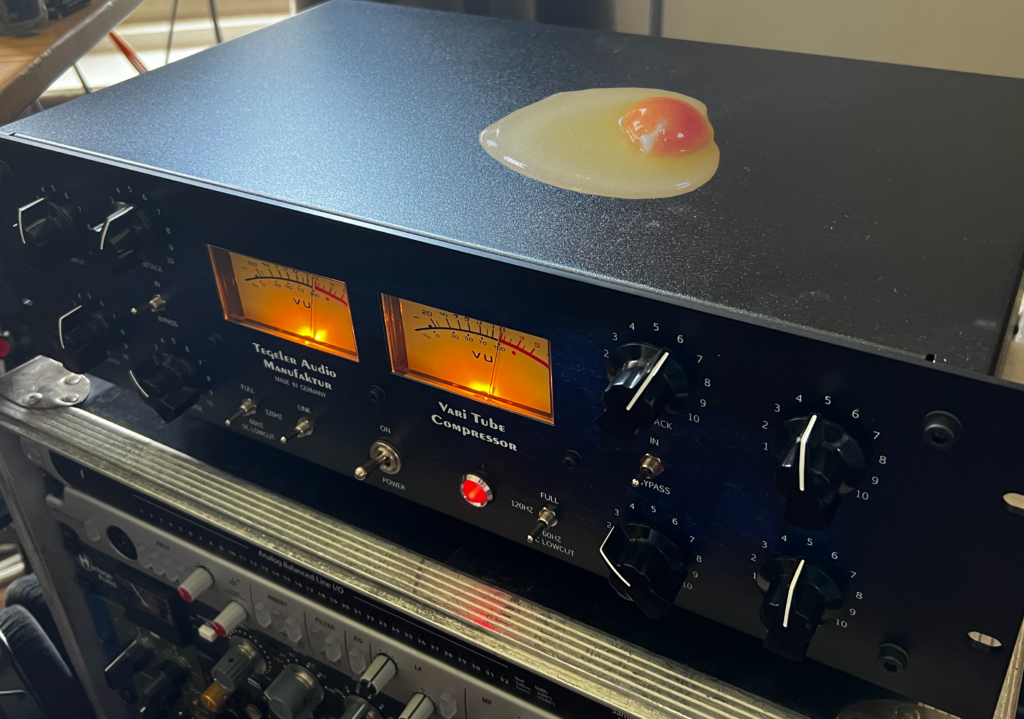
I wouldn’t hesitate to pull the VTC in on a tracking session either. Drum overheads or room mics? In a heartbeat. Vocals? Oh yes, most definitely. In fact, as a vocal front-end, its ability to somehow be colorful and transparent at the same time would make this a first choice. Even with converters as good as they are, I will always record an effect that I like. Besides, come mixdown time, this unit will be busy on other chores. Tegeler’s portfolio includes a dedicated tube recording channel (the VTRC, or VariTube Recording Channel), so if that’s more what you’re looking for, it might be worth looking at first. But for the quality and workmanship you’re getting at these kinds of prices? You might think about adding both.
MY BLUE HEAVEN
The immediacy and brilliance of the VTC’s sound is not just “because tubes and transformers”. There’s plenty of not-that-impressive tube gear out there, and I still think there are people who vastly overestimate how much change transformers actually make. What sets the VTC, and by extension Tegeler Audio Manufaktur, apart is the clear passion and attention that’s gone into its design, components, and build. This obsessive design work pays huge dividends every time you switch it in.
Seriously, this is as musical a compressor as my ears have ever heard. Remember, we’re comparing this to Mt. Olympus deities like the Fairchild 670, Manley Vari-Mu, and DW Fearn VT-7. Tube compressor topology may not be the newest kid on the block but the VTC’s design hangs right in there in the context of today’s music. And while you will certainly find other compressors that offer more controls and features, the Tegeler VTC gives you a glide path to the polish your mix has been begging for.
The VTC is a musical instrument for engineers – and the nuance it brings to even the most clinical or boring recordings almost feels like cheating. In a word, what the VTC does is magical. I refuse to admit to myself that there are tools that outpace my techniques and abilities. But after just a few days with the Tegeler VTC, I can’t imagine working without it. Seriously, this is nothing short of magic.
Tegeler Audio Manufaktur is distributed exclusively in the US by Vintage King.
As of press time, B Church is currently looking for a buyer for his kidney to fund the purchase of a Tegeler VTC. Interested parties can reach out to [email protected].
- Priced within reach of any serious studio
- Brick shithouse build, with sonics to match
Be the first to leave a review.



